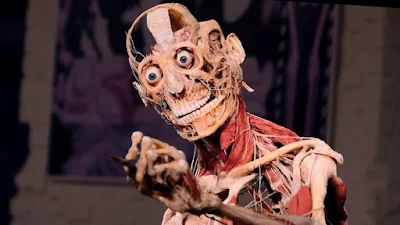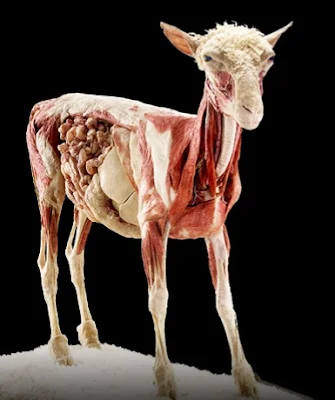Body Worlds exhibitions have received more than 37 million visitors,
making them the world's most popular touring attraction. Body Worlds was
first presented in Tokyo in 1995, and related exhibitions have since
been hosted by more than 50 museums and venues in North America, Europe,
and Asia. Body Worlds 2 & The Brain – Our Three Pound Gem
(concerning the brain and nervous system) opened in 2005 at the
California Science Center in Los Angeles. As of September 2010 it was
showing at the Telus World of Science in Vancouver. Several Body Worlds
exhibits (as well as Von Hagens himself) were featured in the 2006 film
Casino Royale. Among the plastinates seen were the Poker Playing Trio
(which plays a key role in one scene) and Rearing Horse and Rider.
Body Worlds 3 & The Story of the Heart (concerning the cardiovascular system) opened on 25 February 2006, at the Houston Museum of Natural Science. On 9 July 2009 this show appeared at the Buffalo Museum of Science in Buffalo, New York. As of May 2010, it was showing at the Denver Museum of Nature and Science in Denver, Colorado. Body Worlds 4 debuted 22 February 2008 at the Museum of Science and Industry in Manchester in England and was in the Cureghem Cellars in Brussels until March 2009. Body Worlds & The Mirror of Time (featuring human development and aging) debuted at The O2 in London in October 2008. Körperwelten & Der Zyklus Des Lebens (The cycle of life) opened in Heidelberg in January 2009. Body Worlds Vital was inaugurated at the Universum museum of the National Autonomous University of Mexico in 2012.
In 2017, the Tech Museum of Innovation in San Jose, California, opened a semi-permanent exhibition called Body Worlds Decoded. Sponsored by venture capitalist John Doerr and his wife Ann, the exhibit features plastinated specimens supplemented by augmented reality and a digital anatomy table. The exhibit is intended to run for at least 10 years. In addition to temporary traveling exhibitions as of 2019, permanent Body Worlds exhibits are located in Berlin, London, Amsterdam, Heidelberg, Guben, and San Jose (California). Body Worlds is a traveling exposition of dissected human bodies, animals, and other anatomical structures of the body that have been preserved through the process of plastination. Gunther von Hagens developed the preservation process which "unite subtle anatomy and modern polymer chemistry", in the late 1970s.
Body Worlds 3 & The Story of the Heart (concerning the cardiovascular system) opened on 25 February 2006, at the Houston Museum of Natural Science. On 9 July 2009 this show appeared at the Buffalo Museum of Science in Buffalo, New York. As of May 2010, it was showing at the Denver Museum of Nature and Science in Denver, Colorado. Body Worlds 4 debuted 22 February 2008 at the Museum of Science and Industry in Manchester in England and was in the Cureghem Cellars in Brussels until March 2009. Body Worlds & The Mirror of Time (featuring human development and aging) debuted at The O2 in London in October 2008. Körperwelten & Der Zyklus Des Lebens (The cycle of life) opened in Heidelberg in January 2009. Body Worlds Vital was inaugurated at the Universum museum of the National Autonomous University of Mexico in 2012.
In 2017, the Tech Museum of Innovation in San Jose, California, opened a semi-permanent exhibition called Body Worlds Decoded. Sponsored by venture capitalist John Doerr and his wife Ann, the exhibit features plastinated specimens supplemented by augmented reality and a digital anatomy table. The exhibit is intended to run for at least 10 years. In addition to temporary traveling exhibitions as of 2019, permanent Body Worlds exhibits are located in Berlin, London, Amsterdam, Heidelberg, Guben, and San Jose (California). Body Worlds is a traveling exposition of dissected human bodies, animals, and other anatomical structures of the body that have been preserved through the process of plastination. Gunther von Hagens developed the preservation process which "unite subtle anatomy and modern polymer chemistry", in the late 1970s.
A series of Body Worlds anatomical exhibitions has toured many countries worldwide, sometimes raising controversies about the sourcing and display of actual human corpses and body parts. Nevertheless, Von Hagens maintains that all human specimens were obtained with full knowledge and consent of the donors before they died, and his organization keeps extensive documentation of this permission. Von Hagens emphasizes both educational and artistic aspects of his complex and innovative dissections, and offers online teaching guides for educators. He also tries to distinguish his efforts from those of competitors who may have been less thorough in obtaining advance permission from their specimen sources.
Body Worlds has prepared free teaching guides for secondary school education, typically made available through organizations hosting its exhibitions. In 2005, the New York University College of Dentistry experimented with replacing traditional laboratory dissection with the study of dissected and plastinated slices of specimens, for the training of beginning dental students.
The exhibit states that its purpose and mission is the education of laypeople about the human body, leading to better health awareness. All the human plastinates are from people who donated their bodies for plastination via a body donation program. Each Body Worlds exhibition contains approximately 25 full-body plastinates with expanded or selective organs shown in positions that enhance the role of certain systems.
To produce specimens for Body Worlds, von Hagens employs 340 people at five laboratories in three countries, China, Germany, and Kyrgyzstan. Each laboratory is categorized by specialty, with the China laboratory focusing on animal specimens. One of the most difficult specimens to create was the giraffe that appears in Body Worlds & The Cycle of Life. The specimen took three years to complete ten times longer than it takes to prepare a human body. Ten people are required to move the giraffe, because its final weight (like all specimens after plastination) is equal to the original animal.
Many of the whole-body specimens are partially dissected in the Écorché style of 17th and 18th century European tradition, while others are sliced in various anatomical planes to permit understanding of anatomical structure. In addition, more than 200 specimens of real human organs and organ systems are typically separately displayed in glass cases, some showing various medical conditions. Some of the whole-body specimens, such as the "Tai Chi Man", demonstrate interventions, and include prosthetics such as artificial hipjoints or heart valves. Often featured is a liver with cirrhosis, and the lungs of a smoker and non-smoker are placed for side by side comparison. A prenatal display may feature fetuses and embryos, some with congenital disorders.
To produce specimens for Body Worlds, von Hagens employs 340 people at five laboratories in three countries, China, Germany, and Kyrgyzstan. Each laboratory is categorized by specialty, with the China laboratory focusing on animal specimens. One of the most difficult specimens to create was the giraffe that appears in Body Worlds & The Cycle of Life. The specimen took three years to complete ten times longer than it takes to prepare a human body. Ten people are required to move the giraffe, because its final weight (like all specimens after plastination) is equal to the original animal.
Many of the whole-body specimens are partially dissected in the Écorché style of 17th and 18th century European tradition, while others are sliced in various anatomical planes to permit understanding of anatomical structure. In addition, more than 200 specimens of real human organs and organ systems are typically separately displayed in glass cases, some showing various medical conditions. Some of the whole-body specimens, such as the "Tai Chi Man", demonstrate interventions, and include prosthetics such as artificial hipjoints or heart valves. Often featured is a liver with cirrhosis, and the lungs of a smoker and non-smoker are placed for side by side comparison. A prenatal display may feature fetuses and embryos, some with congenital disorders.
The Body Worlds website offers plastinated pieces for sale. There are a wide range of products from plastinated fruit jewelry to entire humans. Although some of the pieces require purchasers to be a qualified use those intending to use the pieces for "research, educational, medical or therapeutic purposes" many pieces, including animal testicles and baby chicks, require no authorization. There are also extremely realistic plastinate impressions of human hearts and slices (including one slice of copulating humans) for sale to the general public.
For more information - Body World




























































